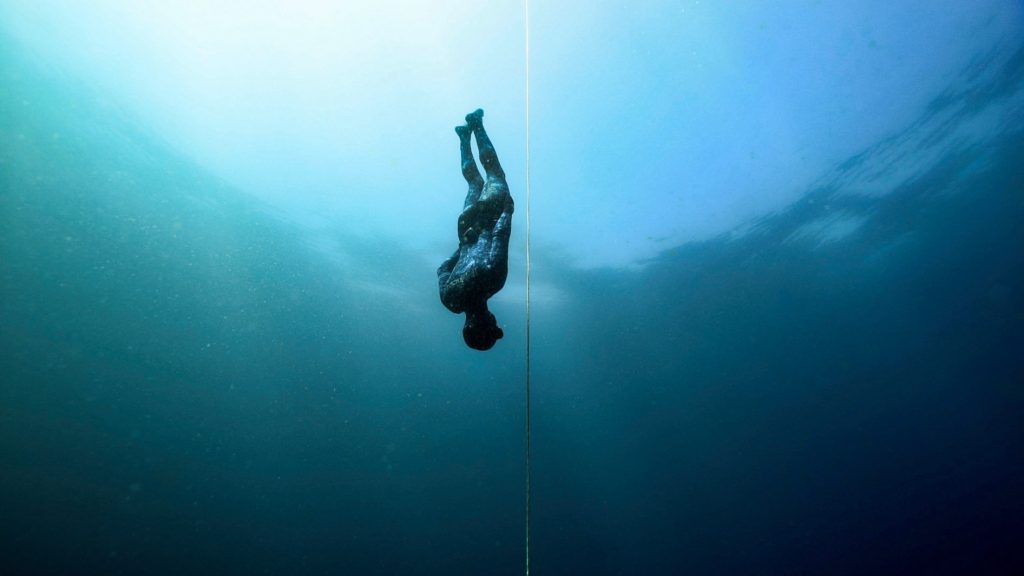In this article we are going to discuss alternatives to dive alarms in a diving computer or how to know what depth are you at during freediving. Let’s start with answering why freedivers use alarms?
First and the most obvious answer is to know where we are. During the freediving we are trying to relax, get into inner state of the mind to conserve the oxygen. We experience lots of fun during a free fall, it is the moment of the dive when we pass the point of the neutral buoyancy and fall down being negatively buoyant. We relax and phase out, we embrace the feelings of the depth, or just observe the surrounding.
Suddenly, we would like to know where we are? What is the depth? Is the time/depth to turn back?

Knowing where we are is very important to stay calm and relaxed, to know we did not pass safety limits of our body. At big depth it gets darker and that is where conventional diving watch does not help us, because we can not see the readings. The situation is even worse in lakes, where visibility drops very dramatically with depth.
I still remember my shock when I was diving in Burrinjuck Lake where at 12 meters of depth I could not see my bright yellow line holding it right in front of my mask. That day it took my some time and visualization to go beyond 20 meters as I was so not used to the darkness.
Using dive alarms instead of reading the number from the watch comes to rescue in those situations. If you have a diving computer like DiveBud you can set depth alarms on descending and ascending depths as well as hanging alarms(time passed since certain depth is reached.).
The second situation is mouth fills, when we dive beyond our residual lungs volume. We would like to know when to do the first and the second mouth fills or start the free fall, for example.
The third situation is about target depth or approaching the target depths. One of my friends told me a story, how he was training for the freediving depth competition and one day he could relax so well that he almost forgot about the turn at the bottom plate. His body passed the bottom plate and a waist-attached lanyard suddenly caught his body exposing him to quite an extreme stretch. That was very dangerous for his lungs as at the big depths we avoid stretches as much as it is possible. So it is recommended to set alarms or be aware of the depth as we approach the target depth and be notified 5-7 meters before to prepare for that.
But what else can we do to know where we are when we are freediving?
The first option is to dive along the marked line and know exactly what do markings mean on it. This is a common practice in training in warm and clear waters, where you can look at the markings or at your watch, but this would not work at the dark lake.
The second option is to count your strokes, kicks or count in your mind. It only works in the beginning of the dive as when we pass the neutral buoyancy point we just fall down and can use this information.
The third option is to count you equalizations. If your equalization is very stable then counting how many equalization movements did you do can be a good indicaton on what depth are you at. For example, I know that it takes me 9 equalization movements to get to 25 meters.
Lastly, you can check nautical charts to see what is the depths in the region where you are going to dive and relying on your vision stay away from the very deep spots. In Sydney, Australia we recommend one more method which is based on visibility of the water. Most of the time the visibility in the bays is between 8-12 meters, so if a freediver sees the bottom it is about 12 meters max, so depending on the level it could be safe to proceed. If you don’t see the bottom, then you need some instruments to help you understand where you are in terms of the depth.
Freedive with a good company!

2 thoughts on “How to know the depth without a diving computer?”
Hi there I just had a few questions about the dive bud. I am very new to free diving so please excuse the ignorance. Are we meant to take the mobile phone with us underwater along with a DIVEBUD attached to our ear? I would imagine that most mobile phones are not suitable for driving and only suitable for immersion just below the water surface. For example my iPhone 7 is only rated to a depth of 10 feet. If we did leave the mobile phone attached to a float at the surface of the water, how does the DIVEBUD communicate at a distance of say 50 m from the mobile phone underwater. Thank you
Hi Rajdev,
DiveBud is fully autonomous, you don’t need to take your phone with you. You need to connect DiveBud to your phone to setup the diving alarms. DiveBud will store all the alarms internally. Also, DiveBud will store up to 50 diving logs. So, after you finished diving and come back to the shore you can connect it to the phone and download the logs.